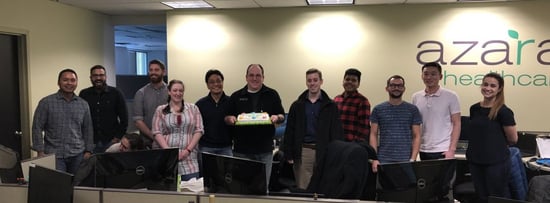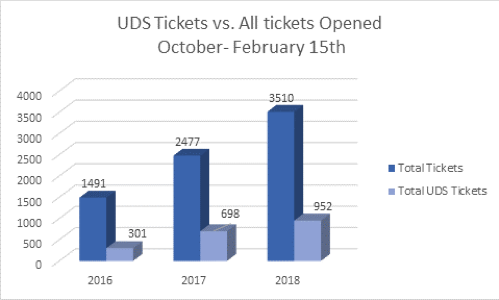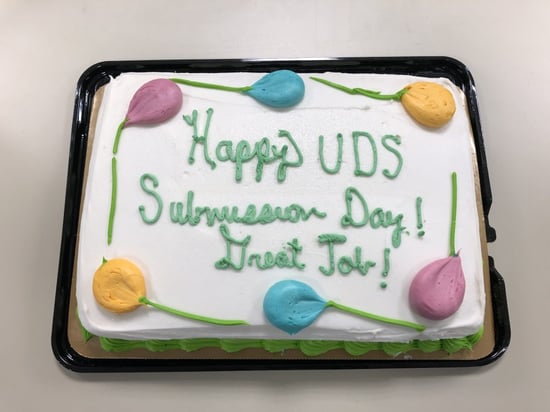Hello from a seasonably cold, but not too snowy Boston! I can hardly believe we are entering the back half of February and will soon be headed into March and to the NACHC P&I Conference in Washington DC. As we exit UDS Season, I wanted to take a moment to reflect on my observations.
I hope this year’s filing was easier than last year’s and you felt more confident than ever about your submission. After eight years at Azara, I have come to expect the controlled and sometimes, not so controlled, frenzy in our office this time of year, and I remain in awe of the sheer volume of work that gets completed by the Azara team between December 1 and the February 15thfiling deadline.
For Azara, a company that specializes in data reporting and analytics (including UDS) for Community Health Centers, this period is, by far, our busiest time of year. This year, the number of questions and support requests increased 27% over normal volume. Tempers – of both our clients and our staff – sometimes flare, and we dedicate extra staff and hours to ensure we support all our clients promptly. In January and February, we held three after-hours sessions to focus solely on UDS tickets. Almost everyone in the company stayed late, most pitching in to help with UDS and those not qualified, like myself, doing other Azara things, but hanging out to show moral support for the team. Of course, we also try to use these late nights as reasons to order in dinner and facilitate enhanced teamwork and comradery.

As with last year, I didn’t sense the widespread panic, the last minute madness, or the caffeine-fueled craziness that we experienced in our earlier years. Plenty of clients needed assistance, had questions or needed something fixed, but in the past two years, something has felt distinctly different. As I wonder and analyze why I did what anyone who runs a reporting and analytics company might do: I sought answers in the data. First, I confirmed this was our busiest year ever. Our team closed nearly 1,000 UDS related support tickets in the two months preceding Feb 15th, for a total of 2,100 closed tickets in that timeframe To give this some perspective, I looked more closely at our support logs and ticket volumes. I discovered that our UDS ticket volume increased by 36% over last year, which nicely coincides with our 40% increase in live clients in 2018.

These numbers tell me that we (Azara and our clients) are making progress. Our clients are getting a better handle on their data, following their UDS numbers throughout the year and they do a better job of incorporating data into their everyday health center operations.
I often tell Azara clients and prospects: “Those who use their data the most have the best data.” I feel UDS Season is akin to the annual achievement test of this mantra; while I can’t state empirically that this year’s achievement scores rose for all our clients, I’m confident the average increased again.
Clients that use their DRVS data (or any reporting tool) as part of their daily routine are typically well prepared to report UDS, and they find minimal discrepancies with their numbers and performance. This isn’t surprising, because they’ve been viewing data and reports regularly throughout the year – some reports daily. By doing so, these clients can identify data discrepancies early – whether process or product related – and can make fixes well in advance of UDS submission deadlines. In fact, clients that use Azara’s Patient Visit Planning (PVP) report as part of their care planning and delivery are consistently in a much better position than those who don’t, because the DRVS data is already part of their daily workflow.
Data quality and fidelity require ongoing vigilance. All care providers must promptly and adequately document the care they deliver so that they can receive proper credit for their work. In 2018, Azara introduced a set of Data Quality Dashboards with a related group of Measures and Reports to help identify bad EHR data entry or anomalies in data source submissions. If you have not seen these, I encourage you to take a look next time you log in to DRVS. Just as a salesperson keeps score by tallying up total sales, providers who regularly monitor their performance know where they stand long before year’s end. They also know – early in the year – if adjustments in processes are needed to improve the full year’s outcomes.
Congratulations to those of you who finished your UDS submission with less effort, pain, and angst than last year. Take comfort in knowing your year-round hard work has paid off. Also for everyone, it’s not too early to think about next year’s UDS. Look at your data early and often. Make it part of your workflow. Review the Azara Data Fidelity Webinar (DRVS Help Section) for some useful tips and tricks and don’t be shy about asking your network, PCA or Azara for help.
Also, some Azara staff will be in Washington, DC at the NACHC P&I meeting from Tuesday, March 26ththru Friday, March 29th. Please feel free to reach out if you would like to schedule a meeting or discussion with us.

